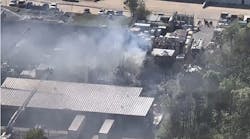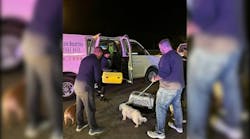Many agencies describe themselves as full service or customer oriented, but that's in name only. Most outfits discontinue customer contact when the fire is overhauled or the patient is transported to the hospital. Fire departments must look beyond the traditional and seek logical opportunities to add value to their service delivery. Further, we discussed just how critical it is to be able to perform our "core" functions well. We must be able to deliver great fire/EMS/rescue and hazardous materials services to our communities, before we can tackle customer service issues.
This article will discuss the "nuts and bolts" of the Dothan, AL, Fire Department's customer service venture. We will review the partnerships and operational utilization of the customer service process.
Customer Advocates
A well-rounded, multi-disciplined committee was formed about a year and a half ago to develop our program. Our major partners consist of the Wiregrass Chapter of the American Red Cross, Dothan Salvation Army and Dothan Fire Department Ladies Association. These groups meet regularly to discuss our effectiveness and seek additional service delivery opportunities. Further, each agency sends a representative, when possible, to after-action incident critiques. This provides valuable feedback from an entirely different perspective. These three agencies have always been customer advocates; therefore, they can relate to the needs of the family members that were harmed. Their suggestions usually lead to improved services to our customers in their greatest hour of need.
The most important part of this service system unfolds during the emergency incident. Each of these organizations has been issued a fire department alpha-numeric pager. The concept was to build an activation capability that was easy to use by the incident commander and by the requested agency. The belief is, that if the system is simple to use, it will be used properly and at the correct times.
So far, this logic has proved to be accurate. This action unfolds from the back of our battalion "buggies." They have been very effectively laid out and serve well as command post vehicles. The support group pagers can be easily activated from our field command post(s) or through our emergency communications center. Typically, within a few minutes the selected group(s) telephone back to receive their assignment and start their response to the incident.
We feel a strong obligation to help our harmed customers with the appropriate agency referral to begin the personal recovery cycle. By having the various agencies report to the alarm location, we are able to implement the process sooner and limit the confusion experienced by the families that are in need. The Red Cross provides emergency shelter for a period of time. Typically, it is able to write a voucher on location that is accepted by several motels in our town to take care of immediate housing needs. The Red Cross can assist with medical and eyeglass prescriptions, clothing and rent payments in some cases. It is amazing to watch the Red Cross volunteer workers explain the services that the family is eligible to receive through their agency. Just hearing someone express a caring concern at this most vulnerable time, provides a family with some reassurances that their lives can be put back together.
The Salvation Army has several specific roles that it is always willing to handle. It provides emergency housing at its shelter, where a family can be housed and have meals provided. Further, the Salvation Army opens its thrift shop to fire victims at no cost. Family members can obtain used furniture, clothing and other essential household items from the Army as soon as they find another place to live.
The other responsibility that the Salvation Army helps with is to provide food and drink for the firefighters on the scene of major emergencies. This may not seem like customer service stuff, but by helping to rehab our members, we are then in a better position to deliver services to those in need. Whenever requested, the Salvation Army can provide religious guidance to family members that are in stress.
The third partner of our customer service committee is the fire department's Ladies Association. This group is comprised of the wives, girlfriends and mothers of our firefighters. (The group was formed long ago, before we had female members, so no hate letters please). The Ladies Association provides the burned-out family with all of the necessary personal items to get through the next couple of days. These "care packages" consist of toiletries, underclothes and diapers for infants. These items may not seem significant, unless you don't have a toothbrush and toothpaste with no means or time to get them.
The Ladies Association will help with other ways to support the families that are in great need. For instance, the members made a Christmas for a family that was burned out in mid-December. Also, they are kind enough to contribute regularly to our smoke detector fund.
Ranking Member Assigned
Typically, the incident commander will assign a ranking member to serve as the customer service sector officer. This person will begin meeting with the family members that are at home and assessing their needs during the emergency. This member will explain the operations of the department at this time. By being specific in the details as to why we performed a certain task, we can eliminate complaints caused by misunderstandings - the average resident will not understand why the fire department had to cut a hole in the roof to extinguish an attic fire. The customer service sector is able to help a family to make more sense out of how we deliver suppression services.
Once he or she has determined which agency or agencies are appropriate to respond, this member will ensure that they get paged out. The selected organizations are asked to call the cell phone at the operational command post. The customer service sector officer explains to the requested group(s) the requirements of the family in trouble. The social service agencies that are summoned, seem to call the customer service sector officer back in a matter of minutes. Within 30 minutes, the various agencies are usually on location and in face to face contact to the customers.
About a year ago, we activated a vehicle that we call "customer service unit." A standard work van was selected to serve this purpose. The truck is equipped with water-removal devices, a large quantity of salvage covers, sheeted plastic, plywood, moving cartons and other assorted items that are used to help the owner/occupant with the protection and recovery of their property. There are tables, chairs and other materials (such as a pop-up tent for rainy weather, lighting, ink pens, etc.) that are used by the customer service sector officer. From this location, the distressed customers meet with the social agencies and complete the required paperwork.
This vehicle gets the customers away from the command post and at a standard location where we can focus on their needs. The incident commander can stay on track and concentrate on managing the ongoing activities rather than attempt to help the victims. The activated social agencies are asked to meet at the "customer service unit" to start their work, once again, limiting the confusion and activity at the command post.
A Success Story
We have recorded many success stories using this customer service delivery model. I would like to close with one of the most powerful ones.
Early one morning, we were dispatched to a house trailer on fire. Upon arrival, the companies were confronted with a single-wide unit that was heavily involved in fire. Within just a few minutes, the two 1 3/4-inch hoselines made short work of extinguishing the fire. However, nearly everything in the home was destroyed by the fire.
As we would learn, a 4-year-old child had played with a cigarette lighter that had caused the blaze. The mother had to rescue the child from the burning bedroom. She then unsuccessfully tried to extinguish the fire with a nearby garden hose before calling 911. The delay simply added to the damage, as well the young mother received a small third degree burn to her leg. The Red Cross was paged and asked to report to the scene to help with temporary housing for this family of three.
Before the overhaul process could be completed, Red Cross members were on location and rolling up their sleeves. The Red Cross volunteers made arrangements with the mobile home park to relocate the family to an empty trailer just a few blocks away. The husband arrived at the disaster and was overwhelmed with the sight. His first reaction was to express his concerns in a very negative way toward his injured wife. Once he learned that the Red Cross had relocated his family to another home, he calmed down. The family, the Red Cross and the fire department moved the salvaged items to the new home.
Witnessing this situation has added to my belief and commitment to the customer service process. It did not take any extra time or resources and only a little more effort on the part of the department. The effect that this act of kindness had on this family in true need was tremendous. All of our members that participated expressed their appreciation to the Red Cross and realized that they did just a little more good for our community. We were able to treat the customer in a way that we would like to be treated.
This may sound "corny," but it becomes the standard that you should apply to your customer service efforts. The Red Cross was able to finish the job of helping the citizens that were in great distress in a way that we are not able to help. Through agency teamwork, more of the harmed families needs are met. In days gone by, most fire departments would have never considered themselves as part of the social services system. Some still resist this most logical and effective connection.
Look forward to more interagency relationships to be developed by our fire department. This appears to be a logical way to expand our service delivery capability to empower our members to help.
Dennis L. Rubin, a Firehouse® contributing editor, is chief of the Dothan, AL, Fire Department.






